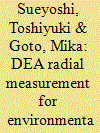|
|
|
Sort Order |
|
|
|
Items / Page
|
|
|
|
|
|
|
| Srl | Item |
| 1 |
ID:
092813


|
|
|
|
|
| Publication |
2009.
|
| Summary/Abstract |
This study investigates the causality from environmental investment (as a long-term effort) and expenditure (as a short-term effort) to financial performance in the US electric utility industry. The industry is one of the large air polluters in the United States. This empirical study finds that the environmental expenditure under the US Clean Air Act has had a negative impact from 1989 to 2001. The negative impact has become much effective after the implementation of the Title IV Program (1995) of the US Clean Air Act. This study cannot find the influence of environmental investment on financial performance by a statistical test although it indicates a positive impact. In the United States, fossil-fueled power plants such as coal-fired ones still produce a large portion of electricity. The generation structure is inconsistent with the betterment in the US environmental protection and imposes a financial burden to electric utility firms.
|
|
|
|
|
|
|
|
|
|
|
|
|
|
|
|
| 2 |
ID:
092768


|
|
|
|
|
| Publication |
2009.
|
| Summary/Abstract |
Many economists such as Wilson (2002) [Wilson, R., 2002. Architecture of power market, Econometrica, 70, 1299-1340] have considered that there are similarities between electricity and gas services in the US electric utility industry. Hence, they expect a synergy effect between them. However, the two businesses do not have technology similarities at the level that the gas service produces a synergy effect with electricity. To examine whether there is a synergy effect of corporate diversification in the industry, we compare electricity-specialized firms with diversified utility firms in terms of their financial performance and corporate value. The comparison indicates that core business concentration is more effective for electric utility firms than corporate diversification under the current US deregulation policy.
|
|
|
|
|
|
|
|
|
|
|
|
|
|
|
|
| 3 |
ID:
111348


|
|
|
|
|
| Publication |
2012.
|
| Summary/Abstract |
Energy policy depends on a proper use of methodology in guiding a large energy issue such as the global warming and climate change. DEA is one of such methodologies that are often used for preparing environmental policy, which is closely linked to various energy issues. Unfortunately, the use of DEA applied to environmental policy is insufficient, often misguiding policy makers and other individuals who are involved in energy issues. This study provides three guidelines for a use of DEA in preparing environmental assessment. First, it is important to prepare both primal and dual formulations to confirm whether information regarding all production factors (i.e., inputs, desirable and undesirable outputs) is fully utilized in DEA assessment. Second, DEA has model variations in radial and non-radial measurements. It is necessary for us to examine environmental issues by different models in order to avoid a methodological bias existing in those empirical studies. Finally, DEA environmental assessment needs to incorporate the concept of natural and managerial disposability. The natural disposability indicates that a firm negatively adapts a regulation change on undesirable outputs. In contrast, the managerial disposability indicates that a firm positively adapts the regulation change because the firm considers the regulation change as a new business opportunity.
|
|
|
|
|
|
|
|
|
|
|
|
|
|
|
|
| 4 |
ID:
103617


|
|
|
|
|
| Publication |
2011.
|
| Summary/Abstract |
Sueyoshi et al. (2009) have examined a synergy effect between electricity and gas services in the US electric utility industry. They have compared electricity-specialized firms with diversified utility firms in their financial performance and corporate value. A problem of their study is that it has not empirically measured the operational performance of the electric utility firms. As an extension of the preceding study, this research investigates the operational performance of 104 US electric utility firms (1990-2004) by fully utilizing DEA (Data Envelopment Analysis). This study finds the three new policy implications. First, the synergy effect has not existed in the operational performance of diversified utility firms before and after the deregulation on the US electricity markets. Thus, core business concentration is more effective for electric utility firms than corporate diversification to enhance their operational performance under the current US deregulation policy. Second, the operational performance has had an increasing trend until 1996 and a decreasing trend after 1996. Thus, the US deregulation policy has been influential on their operational performance. Third, the enhancement in operational performance of electric utility firms has improved their financial performance. The improvement in financial performance has increased their corporate value. Thus, this study finds the business causality among operational performance, financial performance and corporate value in the US electric utility industry.
|
|
|
|
|
|
|
|
|
|
|
|
|
|
|
|
| 5 |
ID:
094838


|
|
|
|
|
| Publication |
2010.
|
| Summary/Abstract |
Data Envelopment Analysis (DEA) has been widely used for performance evaluation of many organizations in private and public sectors. This study proposes a new DEA approach to evaluate the operational, environmental and both-unified performance of coal-fired power plants that are currently operating under the US Clean Air Act (CAA). The economic activities of power plants examined by this study are characterized by four inputs, a desirable (good) output and three undesirable (bad) outputs. This study uses Range-Adjusted Measure (RAM) because it can easily incorporate both desirable and undesirable outputs in the unified analytical structure. The output unification proposed in this study has been never investigated in the previous DEA studies even though such a unified measure is essential in guiding policy makers and corporate leaders. Using the proposed DEA approach, this study finds three important policy implications. First, the CAA has been increasingly effective on their environmental protection.
|
|
|
|
|
|
|
|
|
|
|
|
|
|
|
|
| 6 |
ID:
088985


|
|
|
|
|
| Publication |
2009.
|
| Summary/Abstract |
Deregulation of Japanese electric power industry began in 1995. After the amendment of Electricity Utility Industry Law in 1995, competition was partially introduced in a generation sector and retail competition started from 2000. Eligibility to choose suppliers was gradually extended from larger to smaller customers. As of 2008, almost all customers except households can choose their electricity suppliers. Based upon both previous implementation result of competition policy and review on their achievement, Japanese government will begin new policy debate in 2013 to assess further retail competition which includes household customers. To prepare for policy suggestion on the future electric power industry, this study examines the cost structure of Japanese electricity distribution. For the purpose, we estimate a multi-product translog cost function of Japanese electricity distribution from 1983 to 2003. Using the estimated cost function, we calculate several economic measures such as productivity growth, technical change and economies of scale and scope. The empirical results of this study indicate the improvement in productivity growth after deregulation.
|
|
|
|
|
|
|
|
|
|
|
|
|
|
|
|
| 7 |
ID:
098639


|
|
|
|
|
| Publication |
2010.
|
| Summary/Abstract |
This study proposes a new use of Data Envelopment Analysis (DEA) to measure the operational, environmental and both-unified efficiency measures of US coal-fired power plants. The power plants produce not only desirable outputs (e.g., electricity) but also undesirable outputs (e.g., CO2 and NOx) as a result of their plant operations. A Range-Adjusted Measure (RAM) is used as an original non-radial DEA model. Then, it is reformulated for handling undesirable (bad) outputs. The proposed use of DEA models measures the environmental and unified performance of power plants under two variable alternatives (with and without CO2 emission control) in order to examine both the influence of US Clean Air Act (CAA) on the acid rain causing gases (NOx and SO2) and its extension to the CO2 regulation. This study finds that the acid rain program under the CAA has been effective on the emission control of SO2 and NOx produced at US coal-fired power plants. Moreover, additional regulation on CO2 may enhance their environmental and unified performance. Thus, it is recommended that the US federal and state governments need to expand the legal scope of CAA to the emission control on CO2 because the gas is considered as a main source of global warming and climate change.
|
|
|
|
|
|
|
|
|
|
|
|
|
|
|
|
| 8 |
ID:
121277


|
|
|
|
|
| Publication |
2013.
|
| Summary/Abstract |
This study examines the cost structure of Japanese electric power industry to investigate whether a structural reform on the industry really enhances a cost-saving benefit to consumers. A composite cost function model, using a panel data set, is used for this study. The data set consists of nine electric power companies from 1990 to 2008. Based upon the estimation results, this study examines whether economies of scale and vertical economies exist in the industry. Then, this study conducts a cost subadditivity test that is a necessary condition of natural monopoly. The empirical results indicate that the electric power firms exhibit the status of economies of scale in their transmissions and distributions and the operation as a whole. However, they do not exhibit economies of scale in their generations. Thus, the transmission operation, by integration, in a large area can improve its economic efficiency. Furthermore, the industry should introduce more competition in both generation and wholesale power markets where more firms can participate in their power trades. This study also empirically confirms that vertical economies have existed in the industry. Moreover, this study confirms that all the estimates in the cost subadditivity test satisfy the necessary condition of natural monopoly, where each estimate indicates cost saving in cost subadditivity. The test does not guarantee a sufficient condition of natural monopoly. However, it clearly indicates that the functional separation between generation and transmission will increase total production cost in the industry. The complete separation may result in a net loss of economic efficiency if a competition benefit does not exceed an expected economic loss. Consequently, this study suggests that the industrial structure of future Japanese electric power industry should be evaluated from not only an expected benefit by introducing competition but also an unbundling cost that occurs with a loss of vertical integration.
|
|
|
|
|
|
|
|
|
|
|
|
|
|
|
|
|
|
|
|
|